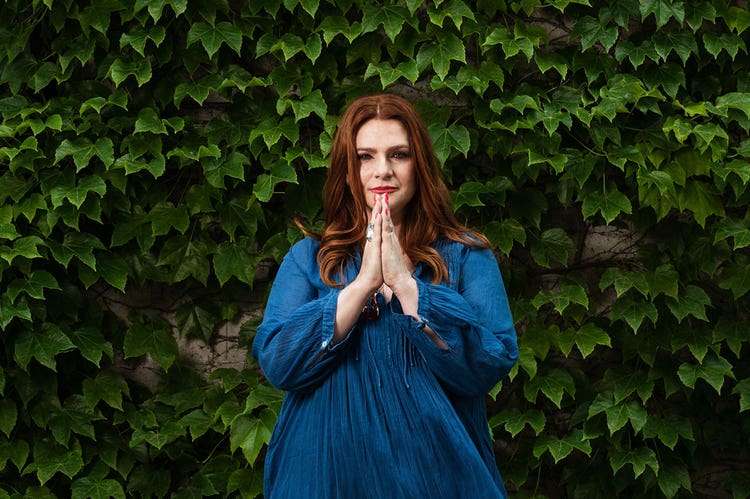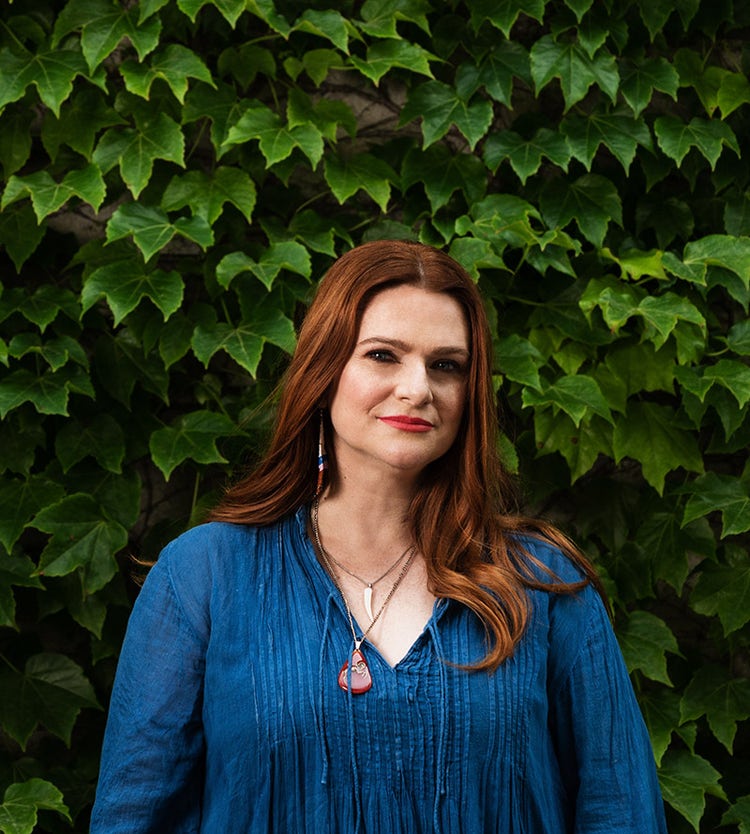Intuition: An Expert’s Tips on How Movement Creates Clarity

When that inner voice tells you to get off the train at a different stop to explore, or to take a photography class even though you haven’t picked up a camera in years, or when you get the urge to find your goggles and do laps in the pool … do you listen?
Intuitive counselor and space designer Elana Kilkenny has reason to encourage you to make that choice. What intuition is not, Kilkenny says, is a crystal ball. You won’t find a yellow brick road to your perfect body, job, relationship or life. What it is, however, is a powerful tool for gathering information and making decisions.
Divine truth

Kilkenny is an empowerment psychic. This sounds woo woo, but it is not. She partners with her clients and coaches them to discover and finally trust their bodies and their direct experience and to use this data to make better choices. Rather than focusing on predictions, she sees patterns and helps clients discern between those that help and those that don’t. Her very specific feedback helps clients understand what changes need to be made, and her practical techniques help incorporate those changes into daily life.
After years of naming what friends, family and co-workers were thinking, feeling and experiencing, Kilkenny finally listened when a healer who was working with her asked, “You know you’re psychic, don’t you?”
Kilkenny accepted her talent and honed it over the last two decades through psychological and physical study, developing her unique approach to clearing behavioral patterns and self-talk—freeing clients to notice their own observations and reactions.
Recognizing that intuition is carried in an imperfect human vessel, Kilkenny’s method detects old stories we’ve constructed about ourselves that can be mistaken for inner truth. The practice also makes it possible to keep others’ behavior from triggering those internal responses.
24Life recently met with Kilkenny to find out how to make practical use of intuition, and her tips might surprise you.
Learn to spot intuition

Recognizing that busyness and distraction make it hard to hear intuition or easy to bypass it, Kilkenny has observed some telltale signs. “Some people get information almost like someone’s speaking to you,” she explains. “Other people feel it kinesthetically through different parts of their body. Intuitive messages through the body usually come through the stomach or a sensation in the head.”
There can be external signs, too. Kilkenny says to notice the synchronicity of a message within an advertisement on the side of a bus, or a song with particular meaning, or someone saying exactly what you were thinking, or calling you out of the blue. The more you pay attention, the more your intuition grows.
That’s why Kilkenny describes intuitive healing as an active practice. She begins her day by tuning into her own energy first. Then it’s important for her not to take on others’ energy—a boundary that allows her to stay clear and serve her clients. For Kilkenny, breath is a versatile tool in her day-to-day routine, enough to let her pause and observe that someone else’s anger or upset belongs to that person.
Tune your space

Our homes and workspaces can be a major source of distraction from intuition, according to Kilkenny. In addition to the presence of objects, artwork and furniture, the ways and reasons they were acquired also come into play and inform these items with meaning. The painting inherited from an uncle, the sofa you bought with your ex, the paperweight your niece made at school, the mirror you hung facing the door—all have the potential to be your symbols or to carry stories that might best be let go.
(For those who subscribe to Marie Kondo’s renowned practice, the joy an object brings might still be worth examining.)
- Look with new eyes. Kilkenny invites clients to take a breath and walk into their homes and see what catches their eye, what they turn away from, what things still “feel like you” and what things don’t.
- Separate stories from symbols. “It’s knowing what are things that you love and why,” Kilkenny says. “You might really love that painting you associate with something reflective of what love or feeling safe meant to you in the past. But it can be problematic if your history with love has been unhealthy or if what made you feel safe came more from feeling a need for protection or from fear. So if these are the underlying feelings behind your choice of art, then perhaps it’s not nourishing you but rather reflecting back a story that’s still hurting you.”
- But don’t overthink it. “You can get that perfect feng shui’d home, but if you’ve done it out of fear [that you won’t get the perfect job or the right partner], you could be laying more fear into your home,” she explains. “The space will reflect back to you that you’re not OK with things not being perfect or that you need more stuff in order to make everything OK.” Instead, from your looking with new eyes, you can choose something to shift or something to add—one item at a time.

Use movement to get unstuck

“There’s this great story about two very famous musicians.” Kilkenny says. One musician has stage fright that she describes as a pulsating sensation that travels up her arm and into her heart. “She says it feels like she’s going to have a heart attack,” Kilkenny says. The other musician appears to go onstage at a deliberately chosen moment. When he’s asked how he knows the right moment, he describes exactly the same sensation as the artist with stage fright.
“Same physiology, same set of information,” she explains, “but one performer is translating this information as a reason to fear going onstage, and the other performer reads this energy as fuel to dare greatly and perform.” Kilkenny tells this story to illustrate the role physiology plays in our stories and how easily it can be confused with intuition.
“Often, information that we’re getting is different from the stories we’re telling ourselves,” Kilkenny observes. “We all have baseline narratives. One of my core stories used to be ‘it’s too late,’ as in, ‘it’s too late to do something vocationally or personally that I desire to do.’ When you get clear on what your story is, then you can question its validity and notice and question it in specific situations.”
Since overthinking is the culprit, Kilkenny says, “many times our best way out is not adding different thinking right away.” The first thing to do, she advises, is to make a physiological shift, “a break that helps us shift the way we think.”
So Kilkenny incorporates movement into her practice. But not just any movement: She begins with breath, pointing out that when we’re stressed out, we often hold our breath or take shallow breaths.
Then, she says, it’s important to consider the type of movement you do. “Let’s say you want to relax more, so you plan to do yoga. If you start doing a vigorous practice or hot yoga or anything that brings Type A energy, you’re still adding more of the same energy into the pattern that you’re trying to change.” With this physical foundation, we’re ready to receive intuition and begin a new chapter.

Find balance

Kilkenny finds the word “balance” to be problematic, one that sets us up for failure. So she regards balance as “knowing there will be seasons in your life when you’re going to be spending more time with certain things and surrendering to that awareness” while at the same time getting clarity on steps that can be taken to help manage those demands in a more balanced way.
“I always think of life in four quadrants: the mental, emotional, spiritual and physical,” she says. “Whenever I’m dipping too much in the mental aspect, I try to bring something in from the other quadrants to balance it out.” She acknowledges that sometimes that means spending more time to replenish her energy and less time with her kids—so that she’ll feel restored and ready to be present with them. “The clearer you can be about what to say yes and no to, the more full-bodied your life becomes.”
To accomplish that clarity when things feel off-balance, Kilkenny takes these steps.
- “ I find that I have to physiologically stop.” To break into her busy thinking, Kilkenny takes a breath.
- “I close my eyes and ask for a higher vision of what needs to be done.” Sometimes, she says, the answer is nothing. “Sometimes you need to wait,” something she admits, with a laugh, is not her innate strength.
- “Sometimes it might not be what you think should happen, but it’s keeping you away from something that you shouldn’t be doing or helping you to pivot in a way that you need to turn,” Kilkenny says.
- “Sometimes stuff just happens,” she says, and humor can break the spell of overthinking so that we can hear our intuition without the burden of our stories.
About Elana Kilkenny
Are you desiring more clarity, support and connection? Elana Kilkenny is fiercely committed to helping you live your most authentic, joyful and wholehearted life. She offers transformative Intuitive Counseling sessions for individuals and couples that provide you with empowering intuitive guidance, spot-on practical feedback and heart nourishment in service of you thriving. She also offers Sacred Space Design services for homes and businesses that potently connect your vision for your life and business with the energy and beautiful design of your space.
All her services are available via Skype (worldwide) and in person in the New York City area (and beyond).
For more inspiration, visit Elana Kilkenny at: Website: elanakilkenny.com
Instagram: @elanakilkenny
Instagram: @sacredhomedesign
Facebook: facebook.com/elanakilkenny

Video credit: patrickeditor, Getty Images;
Photo credit: Mark Kuroda, kurodastudios.com; Dani Costelo, Unsplash; Mark Kuroda, kurodastudios.com; Arno Smit, Unsplash; Taylor Ann Wright, Unsplash; Jordan Whitt, Unsplash